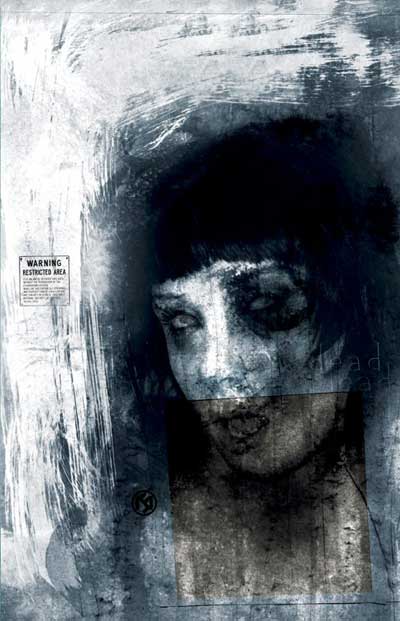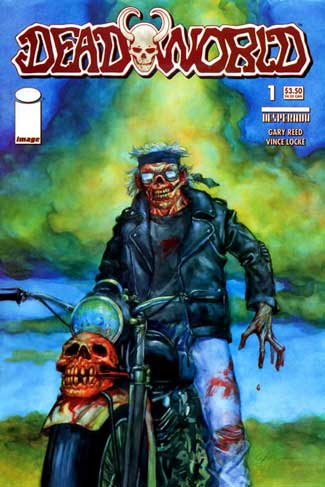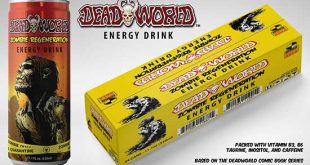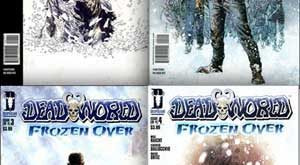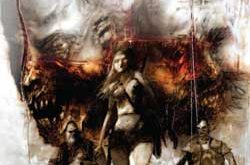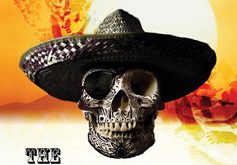 Welcome back kiddies. This time I have lured Gary Reed into the depths to pick his brain about all things Deadworld. So sit back and relax we find out why we should all read be reading Deadworld, and what the future holds for this long running series.
Welcome back kiddies. This time I have lured Gary Reed into the depths to pick his brain about all things Deadworld. So sit back and relax we find out why we should all read be reading Deadworld, and what the future holds for this long running series.
Decapitated Dan: Lets start off simple who is Gary Reed?
Gary Reed: Wow, that’s a tough one. Right now, I’m a college professor in Biology and a free lance writer but am also publisher of Transfuzion Publishing which launched to do primarily collections of previously published material but now heading into doing all new material as well.
In the comics field, I had a chain of comic stores in the Detroit area and used to put on comic conventions and had a radio show on comics for a few years. I started up Caliber Comics and that ran through the 90’s and put up some 1,300 comics and over 70 graphic novels. Caliber gave an opportunity for a lot of young talent to show what they can do and although all of these names didn’t necessarily get their start at Caliber, it was at Caliber that they showed what they could do. Names like Guy Davis, Vince Locke, Michael Allred, Michael Lark, Patrick Zircher, Laurence Campbell, Jim Calafiore, Phil Hester, Paul Tobin, Brian Bendis, David Mack, Michael Avon Oeming, Jim O’Barr, Thomas Sniegoski, Mike Carey, Michael Gaydos, Ed Brubaker, Dean Haspiel, Mark Andreyko, Stuart Immomen, Mark Ricketts, Galen Showman, and many more but these are the ones off the top of my head. We also worked with a lot of already established folks such as Alan Moore, Brian Bolland, Dave Dorman, Warren Ellis, Mike Deodoto, Ian Edginton, Garth Ennis, John McCrae, Paul Jenkins, and many, many others.
Outside of Caliber, I was also Vice President of McFarlane Toys when that company first started and remained there for the first three years.
On a personal level, well, I’ll just keep that personal.
DD: Tell me what your journey through comics has been like so far.
GR: Well, to just keep it in a timeline fashion…started off as retailer in the 1980’s, got involved in publishing in the 90’s, and then closed up everything at the end of the millennium. I was brought in as a writer to adapt some classic novels fro Penguin Books in 2003 and when Desperado launched, the publisher, Joe Pruett discovered bringing back Deadworld so I re-entered the comics market as a freelance writer and creator. In 2007, I started Transfuzion Publishing to reprint some of my earlier material.
Overall, I’ve done well in comics, albeit with some major ups and downs, and I think it is a vastly untapped and creative market. I may not like many of the comics—I don’t read any superhero comics, for example, but I love the medium and I think today’s creators are doing some fantastic titles that may not get the sales and attention but they’re putting comics on the road to becoming a respectable form of storytelling.
DD: What was it that made you want to get into this industry?
GR: I never had a strong desire to get into the industry and in fact, was not a comic reader. I read them when I was a kid and amassed quite a large collection but by the time I hit my teens, I sold them all. I really never looked at them again until I started up my book stores which morphed into comic stores. So, my entry into the comics world, while not accidental, wasn’t expected nor was it desired. But once I did get involved, I gained a great appreciation for the medium and what it could be. Remember that in the 1980’s, comics were evolving into a much more sophisticated form and showed incredible promise that was wiped out in the 90’s but has made a comeback the last decade or so as far as content goes.
DD: How did you get into the comic book business?
GR: I actually got into comics indirectly. I opened a book store and added comics because people came in looking for them. Comics was the growth part of the business and eventually, I had four comic stores while I was going to college. That gave me options and even after earning my Master’s in Biology, the comic side appealed to me more and so that’s the direction I went in.
The publishing started as an offshoot of the retail operation. When Arrow Comics folded because of the crash of the distributors in the black and white glut, Vince Locke with Deadworld and Guy Davis with the Realm came to me to find a publisher for their books. At that time, I had my stores, a radio and TV show, had put on conventions, and was now out of school so I figured I’d publish them myself. How hard could it be? I was talking with some customers who were involved with a movie in the area called Moontrap staring Bruce Campbell and Walter Koening of Star Trek fame and so I did an adaptation of that. Guy and I created Baker Street, Jim O’Barr was a customer of mine who heard about the publishing company and came to me with his project which was The Crow. I added an anthology series to showcase short stories with Caliber Presents, and I had my initial publishing line.
DD: So lets start with your days at Caliber, what was the idea behind doing a book like Caliber Presents?
GR: I wanted the opportunity to do shorter pieces and have a venue where people could do different things. I think Caliber Presents was really successful in that way. We had original short comic stories plus it was an opportunity for regular series to do a short segment. I added an Artist Sketchbook feature and we would run a preview of an upcoming series. I also created a couple of recurring settings and sort of let other people play with them. The serials included Gideon’s about a mystical pawn shop that exists at any time and any place and Street Shadows about the activities that go on in a normal city. Caliber Presents ran 24 issues and then became a series of one shots. Towards the end, another anthology from Joe Pruett, Negative Burn, was rolling along so the emphasis shifted to that which ran for 50 issues.
DD: Moving from that to more of your books, what made you want to give your own take on Jack the Ripper?
GR: I’ve always been fascinated by Jack the Ripper. It wasn’t so much the crimes but even as a kid, I was struck by the enormous social changes that Jack caused. When the East End was being investigated, the people of London, and of the world, were exposed to the horrendous living conditions that were going on there. As a consequence, there was a huge social movement that changed the nature of government in the areas of living and working conditions, education, health, and the treatment of immigrants. That’s why Jack became so infamous as he was the catalyst for exposing the underbelly of London. My take of Jack was pretty much limited to just dealing with the facts and the impact it had.
I’ve always been interested in history and when I started up Tome Press which was a line of comics dealing with history and biographies, well, Jack just fit in perfectly.
DD: Have you always been a fan of horror comics?
GR: Actually, no. I mean as a kid, I read all kinds of comics and horror was part of it. I’m not a big horror fan in the sense that I read horror novels or watch horror flicks. I’m not a monster guy…I’m more drawn to the horrific things that the human psyche is capable of and the rationalizations behind that. So, not so much of a horror fan but rather of how horror can impact people and events.
I really never feel constrained by labels or genres. My favorite movies are dramas as I like interactions of people so no matter what style of fiction that I read, as long as you have great characters, I’m in for it. A lot of horror, especially from writers like King and Matheson, the horror is interlaced with the characters.
DD: Do you feel it is what has lead into some of your titles?
GR: Certainly. Besides Deadworld, I have a number of titles that deal with horror aspects. Some are obviously based on the horror genre such as Helsing or the horrific scenes in Sin Eternal which was released as Sinergy and is an updating of Dante’s Inferno. That allowed me to play with Hell and the horrors for sinners for all eternity. But even in other titles such as Saint Germaine, it was an examination of evil committed by people. I think that Deadworld which seems to be a blatant zombie book is actually more about the horror aspects that people do in response to that situation.
DD: So when you were the head of Caliber how did you hear about Deadworld while it was still with Arrow?
GR: Arrow was a local company as were all the creators. With my stores and my radio and TV shows, we got to know most of the Arrow people and many of them shopped at my main store. As a retailer, I ordered quite heavily on the Arrow titles and was actually buying huge quantities to resell to retailers across the country. It was a completely different market back then.
DD: Could you tell there was something special to be told with this story??
GR: Even at the beginning of the series which was very much influenced by the Romero films, the human characters were developed and it was more than just a zombie chase. With the intelligent zombies, it put a whole different spin on the series and that’s what I found most interesting.
DD: So what made you decide to start writing the series instead of just overseeing it?
GR: As Deadworld was continuing with Caliber from the Arrow issues, Vince was being offered a lot of other work and he wanted to move on from Deadworld. He came on board initially just to draw it and the idea of taking over the writing of it when he assumed sole ownership of it didn’t really appeal to him. We discussed where it should go and as I got more involved in the editing, I guess I got more specific about the direction and it was easier to write it than to explain it to other writers.
DD: When the 6 issue Deadworld series was put out by Desperado/Image, were you trying to start over and have it be an ongoing?
GR: That was the plan. The Image series was geared to be a reboot of Deadworld since it had been so long since the original series came out and those issues were not available in print, even as collections. But once again, the Deadworld curse hit. It’s jokingly called the curse in that it seems almost every artist involved gets hired away. Vince, of course. Mark Bloodworth came on board after Vince and then was tabbed to do Clive Barker’s Hellraiser. Dan and David Day, along with Phil Hester, stepped in but almost immediately got full time gigs at the majors. Galen Showman and Troy Nixey came in for the second volume but again, both went on to bigger and better things. Even with the Desperado and Image series, Dalibor and Federico went onto the majors during their runs on Deadworld. Keeping a regular artist on Deadworld has been nearly impossible. I figured it was best to do mini-series and at least maintain some kind of artistic consistency within that and not deal with the problems on an ongoing series.
DD: What would you say have been the high’s for the Deadworld Series so far?
GR: That’s really hard to say because I always feel that Deadworld isn’t living up to its potential. It always seemed to be scrambling on the production end, again, mainly because of the artists. I liked what was being done in the transition between Vince and Mark Bloodworth but that didn’t last long. I was happy with how the Deadworld: Requiem for the World mini-series from Desperado and Image came out overall even though Dalibor had to come in on the third issue because Vince was in such demand because of A History of Violence. Since he was the artist, when the movie came out, Vince was doing galleries around the country. And of course, I was very pleased with Slaughterhouse even though I would’ve liked to have extended it but Sami Makkon was already pegged for the New York Time’s best selling series, The Looking Glass Wars, so I had to settle just for the four issues.
DD: And the lows?
GR: Again, mainly due to the artist situation, the sporadic scheduling and the mish-mash that occurred at the end of the first volume. I decided to try and get the book out on a regular schedule and knowing that the artists could only be around a short time, I developed different story arcs by different artists so we could move from one to the next. Because they were story arcs, we could deal with the different artists but then none of the artists could complete even their parts so I had three unfinished story arcs developing and so I tried to squeeze them into one coherent saga but in hindsight, probably not the best idea I had. But it is what it is even though I don’t like to look at it. In the second volume, I brought in two young guys and I think I pushed them too hard. They weren’t ready and it showed. Both of them aren’t doing comics now and I feel that maybe I burned them out and I regret that but that’s part of the medium. I certainly don’t blame them, they just weren’t’ ready and I should have done a better job of recognizing that. I think that because there was always enormous pressure to get the book out, I probably didn’t do some proper evaluations.
DD: Deadworld has had it’s fair share of one-shots and mini series since the original 2 runs. Do you ever see it going back to an ongoing?
GR: The one shots were mainly to keep the presence of Deadworld going. The mini-series such as To Kill a King was because the art was so radically different from the regular series, I wanted to keep it separate. Some fans loved it, some hated it…they wanted the traditional style of art so that’s why some things were done as one shots and minis. Whether it goes back to being an ongoing, I don’t know. There has to be a certain level of sales to keep a book going as obviously the artist has to make enough money to get involved with that. If I had enough revenues to ensure an artist could make a good wage on it, hell, I’d take Deadworld to a bi-weekly. But that’s not the case so Deadworld at this time, looks to be a series of mini-series and one shots that can be stand alones yet move the overall story along.
DD: With the Slaughterhouse Hardcover out now, and the Frozen Over mini wrapped up, will we see a big break before the next story?
GR: For 2010, it sort of continues the confirmation of what Deadworld is. Slaughterhouse came out in January and Frozen Over concluded in February so now everything is wrapped up as far as the current storyline goes. By wrapped up, I mean that the storylines are complete but they certainly are not resolved. In the spring there will be a massive collection of the original Deadworld saga featuring all the Vince Locke issues so that’s the first 16 issues. In the fall there will be another large collection that basically deals with the rebooted Deadworld as the Image series, Slaughterhouse, and Frozen Over will all be collected into an Omnibus. Right after that will be an all new Deadworld graphic novel called The Last Siesta which is a self contained story with art by Mark Bloodworth. From there, it’s not decided yet and some of that has to do with what’s going on with the movie. But I’m already working on the next story arc and I’d like to do it as a mini-series with an eye on continuing if it does well.
DD: Touching on what has gone in Slaughterhouse, can the humans ever really win? I mean I hope not but I am a King Zombie-Head.
GR: Sure they can win. I’m a big believer in the human race. They maybe capable of foolishness and mass destruction but also capable of incredible achievements. I always find it amazing what humans are able to do. Since I’m so involved in science, reading of the things going on in genetics and cell biology, if something like Deadworld were to really occur, I have no doubt that the humans would eventually win. Well, I guess that is if the right ones survive.
DD: I want to do a quick kind of word association with you on what has already come out. Please give us a quick recap of the Deadworld Universe:
Deadworld Vol. 1:
The original series which was very good up until the end then the interweaving storylines muddled things up.
Deadworld Vol. 2:
An attempt to right the ship which started off good but again got waylaid. However, when Troy Nixey returned for the last two issues, I thought he did a great job of bringing it all together.
Deadworld To Kill a King:
A satisfying and complete story. I was happy with it and Ron McCain did a good, albeit stylized, rendition.
Deadworld Archives:
Simply a means to get the original series back in print. I think we only did the first three issues.
Realm of the Dead:
I liked the concept and story but the art suffered. I’d like to redo it but sometimes its just best to move on.
Roadkill A Chronicle of the Deadworld:
A prose story by Del Stone set in the Deadworld with spot illustrations by Dave Dorman. What’s not to like?
Deadworld Chronicles The Plague:
Kevin Thomas was a promising artist and he did this one shot became an analogy for the AIDS epidemic. Kevin was the original artist for Slaughterhouse many, many years ago but he got too experimental in the book so it never, and never will, was printed.
Deadworld Chronicles Dire Wolves:
One shot by Chuck Yates which was just an episode set in Deadworld. It served the purpose of the Chronicles to be one shots of Deadworld.
Deadworld Necropolis:
Mitch Waxman having fun with Deadworld and he moved the action to New York City.
Deadworld: King Zombie:
This was to be a mini-series and perhaps ongoing that was written by Tom Sniegoski and drawn by Jacen Burrows. However, after two issues, Jacen got hired away and the sales were disappointing as this was coming out towards the end of the crash in the late 1990’s.
Deadworld Vol. 3:
This is the Requiem for the World series put out by Image. A reboot of the Deadworld series and is the starting point for all things Deadworld from now on.
Deadworld Dead Killer:
This was a one shot that collected the serial that ran in the first volume of Deadworld. Introduced the Dead-Killer and led into the To Kill a King mini-series. All of that was collected into the Dead Killer trade paperback. Dead Killer became one of my favorite characters.
Deadworld Daemonstorm:
Simply a tie into the Daemonstorm saga which was a way of bringing all the various Caliber titles into a shared, although loosely, universe. More of a Daemonstorm story than a Deadworld story.
Deadworld Frozen Over:
Michael Raicht came in to do this story which was to have a mini-series that was part of the continuity yet stand alone. As usual, artistic delays because the artist got hired away by Wildstorm before finishing.
Deadworld Slaughterhouse:
Here I wanted to show the scientific side of things and what extremes people will go in order to preserve the human race.
Crap that’s a lot! I need to start reading more.
DD: So after over 20+ years how much of Deadworld is there left to be told?
GR: It’s much like anything else that has a long history…there is always a lot to tell. I think so many aspects haven’t been fully developed that we haven’t even scratched the surface yet.
DD: Do you find that this universe has a strong following?
GR: Deadworld is a title that has had many people coming and going over the years. It had a incredible impact when Arrow first released the series but in recent years has been joined by an enormous number of zombie titles. But yeah, it seems to have a great following, stronger than the sales would indicate.
DD: What’s going on with the movie?
GR: Not much I can really talk about at this time. David Hayter who wrote Watchmen and the first two X-Men films wrote the script. Reading the script, there are some changes but I think he captures the flavor of it very well and some of the scenes he puts into it really help to cement the whole storyline together. I talked with the producers and we’ve discussed directors and stars but Hollywood works at its own pace so I can’t give any kind of idea at this time of what’s going on exactly…but it is moving ahead at least.
DD: What keeps you motivated to make more?
GR: Again, there’s a lot of directions I’d like to take the story. Most of it deals on the human level and how they respond to a holocaust such as what spawned the Deadworld.
DD: So what does the future hold in store for Deadworld?
GR: Hard to say. With so much going on in my life, I can’t say for certain that I will continue with Deadworld in some kind of future projections but I think that even if I decide to move on, I’d turn it over to someone else. Everything depends on market conditions, the film, and my personal motivation so it’s hard to project. I’ll deal with the situation that is present and continue to do so in the future.
DD: Can you share any great fan experiences you have had over the years?
GR: Probably the more memorable experiences are from my daughters in high school and college talking to people and when a Deadworld fan makes the connection that the Reed girl they’re talking to is the daughter of Gary Reed, the writer of Deadworld. My daughters don’t see my presence outside of the house so that’s always a nice revelation for me to witness.
DD: Alright I will let you out of here after this last question. Why should we all read Deadworld stories?
GR: One reviewer called it the grand-daddy of all zombie comics and I think for that, it deserves attention. I think with the books coming out from IDW this year and the new material coming out at the end of the year, it’s a great foundation to be introduced to a fully fleshed out world of horror that goes beyond the traditional zombie tales.
DD: Thanks Gary. From a huge fan like me I want to thank you for keeping this series going for so long. I grew up in the 90’s so I was not familiar with Deadworld until almost 2 years ago when I got back into comics. But when I saw the Tame cover for Deadworld Vol. 1 issue #5 I knew this was a series I had to know more about. And in doing so I have met some great people along the way and I can honestly say that they all agree this series has helped shape and build on the modern horror comics we see today. It’s just that powerful of a zombie series, that has proven it can stand the test of time.
To learn more about Gary and the Deadworld series please check out http://www.garyreed.net/
Interview: Gary Reed – Comic Artist
 Horror News | HNN Official Site | Horror Movies,Trailers, Reviews
Horror News | HNN Official Site | Horror Movies,Trailers, Reviews


